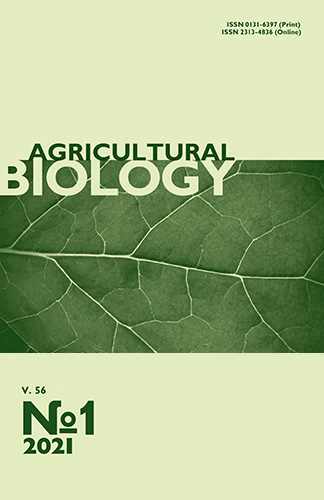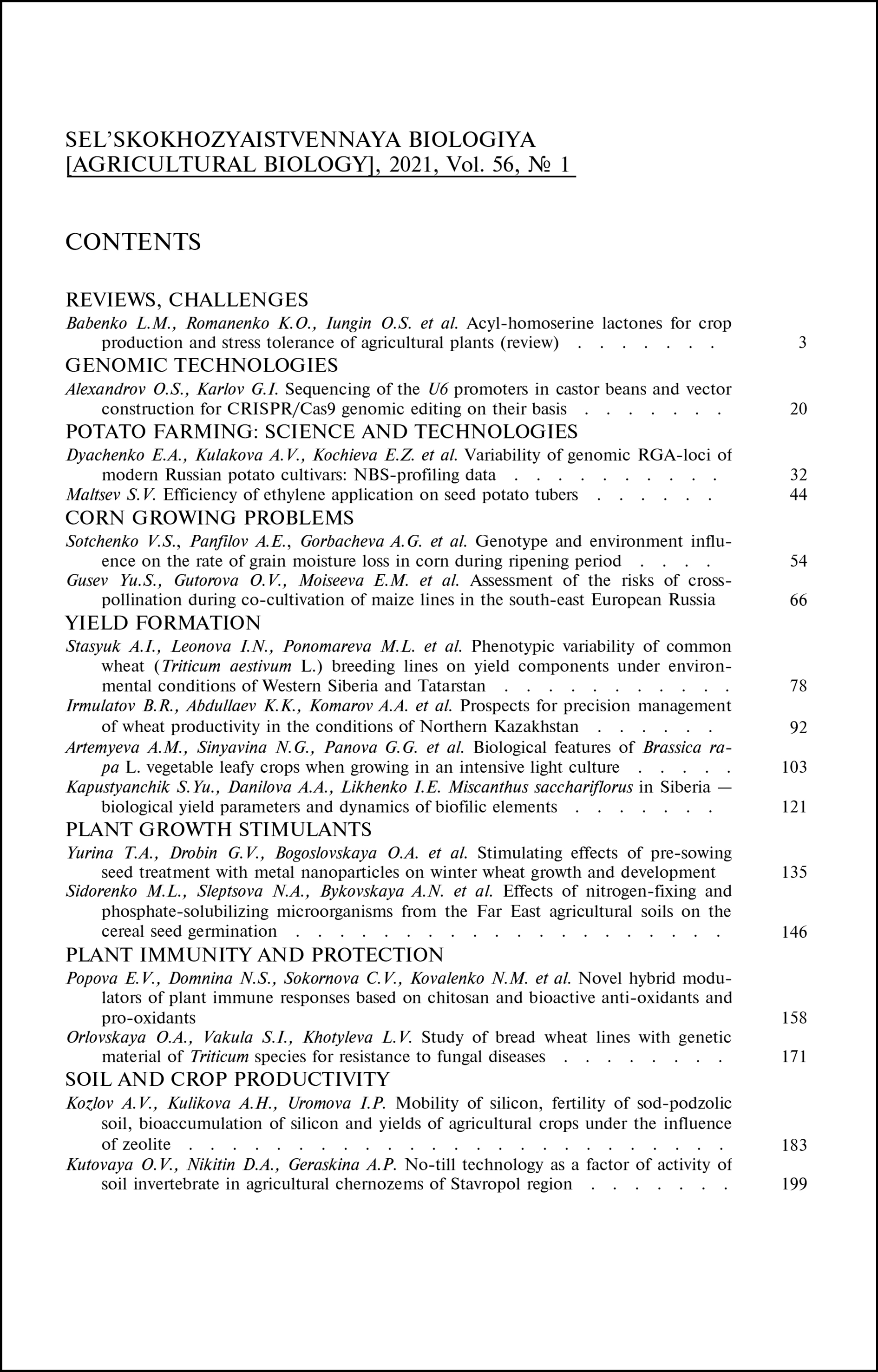doi: 10.15389/agrobiology.2021.1.135eng
UDC: 633.11:631.559.2:631.53.027.2
Acknowledgements:
Authors would like to thank the Ministry of Education and Science of the Russian Federation and the staff of the laboratory of INEPCP FRCCP RAS under the leadership of A.N. Zhigach for the support in the experiments.
STIMULATING EFFECTS OF PRE-SOWING SEED TREATMENT WITH METAL NANOPARTICLES ON WINTER WHEAT GROWTH AND DEVELOPMENT
T.A. Yurina1, G.V. Drobin1, O.A. Bogoslovskaya2 ✉, I.P. Olkhovskaya2,
N.N. Glushchenko2
1Novokubansk Branch of Russian Research Institute of Information and Feasibility Study on Engineering Support of Agrobusiness, 15, ul. Krasnaya, Novokubansk, Krasnodar Territory, 352243 Russia,е-mail agrolaboratoriya@mail.ru, director@kubniitim.ru;
2Semenov Federal Research Center for Chemical Physics RAS, the Talrose Institute for Energy Problems of Chemical Physics, 38/2 Leninsky pr., Moscow, 119334 Russia, е-mail obogo@mail.ru (✉ corresponding author), nnglu@mail.ru, iolkhv@gmail.com
ORCID:
Yurina T.A. orcid.org/0000-0002-6158-5714
Olkhovskaya I.P. orcid.org/0000-0003-2322-7868
Drobin G.V. orcid.org/0000-0002-6673-1776
Glushchenko N.N. orcid.org/0000-0002-0227-9282
Bogoslovskaya O.A. orcid.org/0000-0003-1632-4010
Received June 7, 2020
The use of nanotechnologies in agriculture is an advanced course enabling to reduce the dependence of crop tonnage and quality on external factors. A special section is represented by studies of pre-sowing treatment of seeds with metal nanoparticles (NPs). In this work, it is shown for the first time that pre-sowing treatment of seeds with metal nanoparticles with specific physicochemical parameters affects morphometric indices of the of winter wheat growth at all stages of its development as well as the plant resistance to pathogens, grain quality, the degree of its damage from fusarium and elemental composition of the soil after harvesting. Effects depend on the type of metal used. Our aims were to study i) effects of pre-sowing seed treatment with iron, zinc, and copper NPs on the growth parameters and grain quality of winter wheat, and ii) whether this treatment affects the soil after harvest. Iron, zinc, and copper NPs were obtained by the method of high temperature condensation at the Migen-3 apparatus (Institute of Energy Problems of Chemical Physics RAS, Russia). The shape and size of NPs were evaluated by JSM-7401F scanning electron microscope (JEOL Ltd., Japan). X-ray phase analysis was carried out using an ADP-1 X-ray analyzer (NPO Modern Technologies of Non-Destructive Control, Russia). Field trials were carried out at the validation test site of the Novokuban Branch of the Rosinformagrotech (Krasnodar Territory). The predominant soil type is typical chernozem, with medium humus content, heavy loamy. The sowing of winter wheat (Triticum aestivum L.) cv. Stan was performed on October 4, 2016 with a setting seed rate 240 kg/h. The assigned treatments were as follows: control (seeds without treatment), seed treatment with Fe NPs (5×10-4 %), Zn NPs (1×10-4 %), Cu NPs (5×10-7 %); Fe NPs + Zn NPs + Cu NPs (5×10-4 % + 1×10-4 % + 5×10-7 %). Soil samples were collected for chemical analysis. For phenological and biometric observations, plants were taken from three locations of 1 m2 area from each experimental and control plot. Plant height, average root length, thickness of the main stem at the plant bottom, tillering and depth of the tillering node were measured. Iron, zinc, and copper NPs were round single-crystal structures covered with a semitransparent oxide film. Average diameter of Fe NPs was 27.0±0.51 nm, Zn NPs 54.0±2.8 nm, Cu NPs 79.0±1.24 nm. X-ray phase analysis showed that iron NPs consisted of 53.6 % crystalline metal phase, Fe3O4 content was 46.4 %, and the oxide film thickness was 3.5 nm. Cu and Zn NPs contained only crystalline metal phases with the similar oxide film thickness, 0.5 to 1.0 nm. Pre-sowing treatment of seeds with Fe NPs affected the height of seedlings, promoted the formation of a developed root system with total root length being 4.5 % more (р ≤ 0.05) than in the control group, and increased the seedling stand density by 9.96 % (р ≤ 0.05) vs. control. Pre-harvest monitoring of crops revealed an increase in the yield of wheat plant mass after pre-sowing seed treatment with Fe and Cu NPs. Stem length was larger than that of the control (81.3±1.2 sm) by 3.8 and 8 cm, respectively, the average thickness of the main stem at the plant bottom being larger by 6 mm (when processing with Fe NPs) and 5 mm (when treating with Cu NPs) in comparison with the control (44 mm). Plant stands productivity enhancement after Fe and Zn NPs treatments, higher resistance to pathogens (by 3.85 times vs. control) under Fe NPs, a tendency to an increase in the average 1000-grain weight when using NPs of Fe, Zn, and Cu were observed. The crop quality parameters had higher values as compared to the control: in terms of the content of wet gluten by 6.12 % when seeds were treated with Zn and Cu NPs or with NPs composition; the protein mass fraction was larger under treatment with Cu NPs and the NPs composition by 5.1 % vs. control. Pre-sowing treatment with Fe and Zn NPs reduced the prevalence of Fusarium infection in grain by 1.24 and 2.25 times respectively vs. control. Elemental analysis of the soil after harvesting showed a decrease in the content of mobile forms of phosphorus by 27 % and zinc by 48 % after seed treatment with Zn NPs in comparison with the control, and a decrease in the phosphorus mobile forms by 23 % and sulfur by 7 % after pre-sowing treatment with Cu NPs in comparison with the control. The data obtained demonstrate the effective influence of the pre-sowing treatment of seeds by metal NPs on the growth, development and grain quality of wheat.
Keywords: nanoparticles, iron, zinc, copper, yield components, grain quality, soil trace elements.
REFERENCES
- Ray D.K., Mueller N.D., West P.C., Foley J.A. Yield trends are insufficient to double global crop production by 2050. PLoS ONE, 2013, 8(6): e66428 CrossRef
- Tigchelaar M., Battisti D.S., Naylor R.L., Ray D.K. Future warming increases probability of globally synchronized maize production shocks. Proceedings of the National Academy of Sciences, 2018, 115(26): 6644-6649 CrossRef
- Polishchuk S.D., Golubeva N.I. Vestnik Ryazanskogo agrotekhnologicheskogo universiteta, 2010, 3: 38-39 (in Russ.).
- Golubeva N.I. Vestnik Ryazanskogo agrotekhnologicheskogo universiteta, 2012, 1: 8-10 (in Russ.).
- Duhan J.S., Kumar R., Kumar N., Kaur P., Nehra K., Duhan S. Nanotechnology: The new perspective in precision agriculture. Biotechnology Reports, 2017, 15: 11-23 CrossRef
- Pradhan S., Mailapalli D.R. Interaction of engineered nanoparticles with the agri-environment. J. Agric. Food Chem., 2017, 65(38): 8279-8294 CrossRef
- Elsharkawy M.M., Derbalah A. Antiviral activity of titanium dioxide nanostructures as a control strategy for broad bean strain virus in fababean. Pest. Manag. Sci., 2019, 75(3): 828-834 CrossRef
- Alghuthaymi M.A., Almoammar H., Rai M., Said-Galiev E., Abd-Elsalam K.A. Myconanoparticles: synthesis and their role in phytopathogens management. Biotechnology & Biotechnological Equipment, 2015, 29(2): 221-236 CrossRef
- El-Temsah Y.S., Joner E.J. Impact of Fe and Ag nanoparticles on seed germination and differences in bioavailability during exposure in aqueous suspension and soil. Environ. Toxicol., 2012, 27(1): 42-49 CrossRef
- Feng Y., Cui X., He S., Dong G., Chen M., Wang J., Lin X. The role of metal nanoparticles in influencing arbuscular mycorrhizal fungi effects on plant growth. Environ. Sci. Technol.,2013, 47(16): 9496-9504 CrossRef
- Glushchenko N.N., Bogoslovskaya O.A., Ol'khovskaya I.P. Khimicheskaya fizika, 2002, 21(4): 79-85 (in Russ.).
- Rakhmetova A.A., Alekseeva T.P., Bogoslovskaya O.A., Leipunskii I.O., Ol'khovskaya I.P., Zhigch A.N., Glushchenko N.N. Wound-healing properties of copper nanoparticles as a function of physicochemical parameters. Nanotechnologies in Russia, 2010, 5(3-4): 271-276 CrossRef
- Bogoslovskaja O.A., Rakhmetova A.A., Ovsyannikova M.N., Olkhovskaya I.P., Gluschenko N.N. Antibacterial effect of copper nanoparticles with differing dispersion and phase composition. Nanotechnologies in Russia, 2014, 9(1-2): 82-86 CrossRef
- Rakhmetova A.A., Bogoslovskaja O.A., Olkhovskaya I.P., Zhigach A.N., Ilyina A.V., Varlamov V.P., Gluschenko N.N. Concomitant action of organic and inorganic nanoparticles in wound healing and antibacterial resistance: chitosan and copper nanoparticles in an ointment as an example. Nanotechnologies in Russia, 2015, 10(1-2): 149-157 CrossRef
- Yuan J., Chen Y., Li H., Lu J., Zhao H., Liu M., Nechitaylo G.S., Glushchenko N.N. New insights into the cellular responses to iron nanoparticles in Capsicum annuum. Sci. Rep., 2018, 8(1): 3228-3239 CrossRef
- Shang Y., Hasan K., Ahammed G.J., Li M., Yin H., Zhou J. Applications of nanotechnology in plant growth and crop protection: a review. Molecules, 2019, 24(14): 2558 CrossRef
- Miller A.V., Gen M.Ya. Sposob polucheniya aerozolei metallov. A.s. 814432 (SSSR) IKHF RAN. № 712949/22-02. Zayavl. 19.06.61. Opubl. 23.03.1981. Byull. № 11 [Method for generating metal aerosols. A.s. 814432 (SSSR) IKHF RAN. № 712949/22-02.Appl. 19.06.61. Publ. 23.03.1981. Bull. № 11] (in Russ.).
- Leipunsky I.O., Zhigach A.N., Kuskov M.L., Berezkina N.G., Afanasenkova E.S., Kudrov B.V., Lopez G.W., Vorobjeva G.A., Naumkin A.V. Synthesis of TiH2 nanopowder via the Guen-Miller Flow-Levitation method and characterization. Journal of Alloys and Compounds, 2019, 778: 271-279 CrossRef
- Duran N.M., Medina-Llamas M., Cassanji J.G.B., de Lima R.G., Almeida E., Macedo W.R., Mattia D., de Carvalho H.W.P. Bean seedling growth enhancement using magnetite nanoparticles. J. Agric. Food Chem., 2018, 66(23): 5746-5755 CrossRef
- Ruttkay-Nedecky B., Krystofova O., Nejdl L., Adam V. Nanoparticles based on essential metals and their phytotoxicity. J. Nanobiotechnol., 2017, 15(1): 33 CrossRef
- Ortega L.M., Romero L., Moure C., Garmendia G., Albuquerque D.R., Pinto V.F., Vero S., Alconada T.M. Effect of moisture on wheat grains lipid patterns and infection with Fusarium graminearum. International Journal of Food Microbiology,2019, 306: 108264 CrossRef
- Dimkpa C.O., McLean J.E., Britt D.W., Anderson A.J. Antifungal activity of ZnO nanoparticles and their interactive effect with a biocontrol bacterium on growth antagonism of the plant pathogen Fusarium graminearum. Biometals, 2013, 26: 913-924 CrossRef
- Savi G.D., Piacentini K.C., de Souza S.R., Costa M.E.B., Santos C.M.R., Scussel V.M. Efficacy of zinc compounds in controlling Fusarium head blight and deoxynivalenol formation in wheat (Triticum aestivum L.). International Journal of Food Microbiology, 2015, 205(4): 98-104 CrossRef
- Yasmeen F., Raja N.I., Razzaq A., Komatsu S. Proteomic and physiological analyses of wheat seeds exposed to copper and iron nanoparticles. Biochimica et Biophysica Acta (BBA) — Proteins and Proteomics,2017, 1865(1): 28-42 CrossRef
- Mahakham W., Sarmah A.K., Maensiri S., Theerakulpisut P. Nanopriming technology for enhancing germination and starch metabolism of aged rice seeds using phytosynthesized silver nanoparticles. Sci. Rep., 2017, 7(8): 8263 CrossRef












